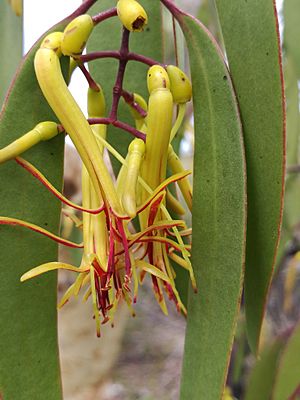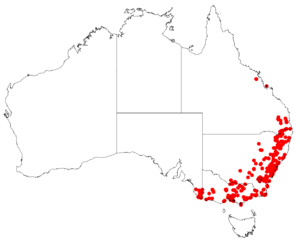Creeping mistletoe facts for kids
Quick facts for kids Creeping mistletoe |
|
|---|---|
 |
|
| Muellerina eucalyptoides on Eucalyptus haemastoma, Ku-ring-gai Chase National Park, 27 January 2017 | |
| Scientific classification | |
| Genus: |
Muellerina (plant)
|
| Species: |
eucalyptoides
|
 |
|
| Occurrence data from AVH | |
Muellerina eucalyptoides, also known as creeping mistletoe, is a special kind of plant that grows in the air. It's a hemiparasitic (meaning it gets some of its food from other plants) shrub that belongs to the Loranthaceae family. This plant is only found in Australia.
Unlike some other mistletoe types, the creeping mistletoe hangs down like a curtain. It also has long "runners" that spread along the bark of its host trees. Its leaves grow in pairs, one opposite the other. You might see its flowers mostly in summer. The flowers grow in clusters, and the fruit looks like a small pear.
Contents
What is Creeping Mistletoe?
The creeping mistletoe is a fascinating plant because it's a parasite. This means it attaches itself to other plants, usually trees, and takes some water and nutrients from them. But it's a "hemiparasite," which means it can also make some of its own food using sunlight, just like a regular plant. It doesn't completely rely on its host.
This plant is found all over Australia. It loves to grow on different types of trees, especially Eucalyptus and Angophora trees.
How Was it Named?
The scientific name Muellerina was first used in 1895 by a scientist named Philippe Édouard Léon Van Tieghem. He described a few species, including the one we now call Muellerina eucalyptoides.
Our creeping mistletoe was first described in 1830 by de Candolle, who called it Loranthus eucalyptoides. Later, in 1962, another scientist named Barlow gave it its current name, Muellerina eucalyptoides.
Animals and Creeping Mistletoe
The creeping mistletoe is an important plant for many insects, especially butterflies and moths! Several types of butterflies lay their eggs on this mistletoe, and their caterpillars then eat its leaves. These include:
- The imperial Jezebel butterfly (Delias harpalyce)
- The common Jezebel butterfly (Delias nigrina)
- The dark purple azure butterfly (Ogyris abrota)
- The Genoveva azure butterfly (Ogyris genoveva)
- The golden or Sydney azure butterfly (Ogyris ianthis)
Moths also love the creeping mistletoe! The mistletoe emperor moth (Opodiphthera loranthi) and the mistletoe moth (Comocrus behri) both use this plant.
Where Does it Grow?
Creeping mistletoe can grow on many different kinds of trees. It's not too picky! Here are some of the plant families and specific trees it likes to attach to:
- Casuarina Family (Casuarinaceae):
* Allocasuarina littoralis * Allocasuarina torulosa * Allocasuarina verticillata * Casuarina glauca
- Cypress Family (Cupressaceae):
* Callitris endlicheri
- Mistletoe Family (Loranthaceae): (Yes, it can even grow on other mistletoes!)
* Lysiana exocarpi * Muellerina celastroides * Muellerina eucalyptoides (It can grow on itself!)
- Wattle Family (Mimosoideae):
* Acacia adunca * Acacia baileyana * Acacia binervata * Acacia decurrens * Acacia floribunda * Acacia implexa * Acacia linifolia * Acacia mearnsii * Acacia melanoxylon * Acacia paradoxa * Acacia prominens
- Myrtle Family (Myrtaceae): (This is a very common host family!)
* Angophora bakeri * Angophora costata * Angophora floribunda * Angophora hispida * Angophora subvelutina * Callistemon lanceolatus * Callistemon viminalis * Corymbia calophylla * Corymbia ficifolia * Corymbia maculata * Many types of Eucalyptus trees, including Eucalyptus haemastoma, Eucalyptus gummifera, Eucalyptus tereticornis, and Eucalyptus pauciflora. * Kunzea ambigua * Kunzea ericoides * Leptospermum trinervium * Leptospermum laevigatum * Leptospermum polygalifolium * Melaleuca ericifolia * Melaleuca linariifolia * Melaleuca styphelioides
- Sandalwood Family (Santalaceae):
- Bottle Tree Family (Sterculiaceae):
It can also grow on some introduced plants (marked with an asterisk * in scientific lists), like Schinus areira (pepper tree), Nerium oleander, Euonymus japonicus, Chamaecytisus palmensis, some Quercus (oak) species, Magnolia grandiflora, Melia azedarach, Platanus orientalis (plane tree), and several fruit trees like Prunus armeniaca (apricot), Prunus avium (cherry), Prunus domestica (plum), Prunus persica (peach), and Pyrus communis (pear).
Image gallery
-
Muellerina eucalyptoides, Ku-ring-gai Chase National Park, NSW, 27 January 2017 (host: Eucalyptus haemastoma)
-
Muellerina eucalyptoides, Ku-ring-gai Chase National Park, NSW, 27 January 2017 (host: Angophora crassifolia)






